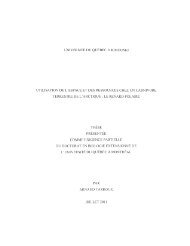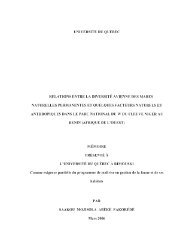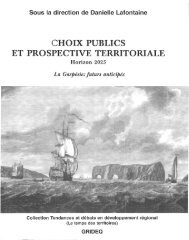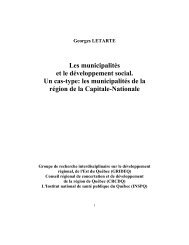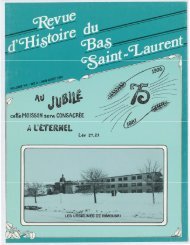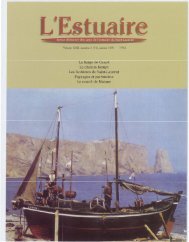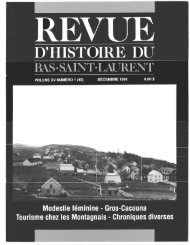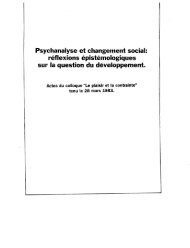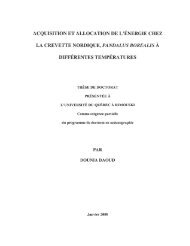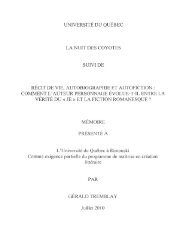influence du climat et de la prédation sur l'utilisation de l'habitat et la ...
influence du climat et de la prédation sur l'utilisation de l'habitat et la ...
influence du climat et de la prédation sur l'utilisation de l'habitat et la ...
Create successful ePaper yourself
Turn your PDF publications into a flip-book with our unique Google optimized e-Paper software.
59<br />
Third, we evaluated the behavioural response of porcupines to variations In Tc. We<br />
recor<strong>de</strong>d time spent outsi<strong>de</strong> of the <strong>de</strong>n, number of activity bouts, and a nocturnality in<strong>de</strong>x<br />
(equation 2 below) for each day (from 00:00 am to 24:00 pm) and compared them to the<br />
mean Tc of the day (recalcu<strong>la</strong>ted from continuous mea<strong>sur</strong>es of Ta, wind speed and n<strong>et</strong><br />
radiation ma<strong>de</strong> at our weather station, equation 3 below). We also compared the <strong>du</strong>ration of<br />
activity bouts to the mean Tc <strong>du</strong>ring the activity bout. Finally, we d<strong>et</strong>ermined which<br />
microhabitats were used when porcupines were outsi<strong>de</strong> of their <strong>de</strong>n, according to Tc<br />
mea<strong>sur</strong>ed in the stand at the time of observation. Because porcupines are sexually dimorphic,<br />
we tested for sexual differences in behaviour.<br />
M<strong>et</strong>eorological conditions<br />
Our automated weather station mea<strong>sur</strong>ed mr temperature In the sha<strong>de</strong> (Ta) using a<br />
temperature sensor (8-bit Temperature Smart Sensor, Hobo, Ons<strong>et</strong>) p<strong>la</strong>ced 1 m above ground,<br />
wind speed using a wind and direction sensor (Wind speed/Direction Smart Sensor, Hobo)<br />
p<strong>la</strong>ced 2 m above ground, and n<strong>et</strong> radiation (0-100 !lm) using a n<strong>et</strong> radiom<strong>et</strong>er sensor (mo<strong>de</strong>l<br />
NR-Lite N<strong>et</strong> Radiom<strong>et</strong>er, Kipp & Zonen) p<strong>la</strong>ced 1.5 m above ground. Ail sensors were<br />
connected to a datalogger (four channels Micro-station, Hobo) that collected data every<br />
minute.<br />
We p<strong>la</strong>ced temperature loggers (SmartButton Temperature Loggers, ACR systems lnc.)<br />
insi<strong>de</strong> nine <strong>de</strong>ns that were regu<strong>la</strong>rly used by porcupines <strong>du</strong>ring our long-term study, but that<br />
were not occupied <strong>du</strong>ring the sampling period. Loggers were p<strong>la</strong>ced on the ground as far as<br />
possible from the entrance of the <strong>de</strong>n (0.5 to 6.5 m <strong>de</strong>ep, <strong>de</strong>pending on <strong>de</strong>n structure).<br />
Loggers recor<strong>de</strong>d temperature every 15 minutes.<br />
Thermal mapping<br />
We worked <strong>du</strong>ring two winters to establish the thermal map: 29 January to 30 March<br />
2004 and 13 December 2004 to 8 February 2005. Following Bakken <strong>et</strong> al.(1983), we built<br />
two heated taxi<strong>de</strong>nnic mounts in the fonn of North American porcupines. To coyer the<br />
copper core we used pelts from animaIs that died naturally in our study area <strong>du</strong>ring winter<br />
2003. We built the mounts in a standing posture with the head facing down. We lined the<br />
insi<strong>de</strong> <strong>sur</strong>face of the hollow copper mould with 24 gauge Teflon-coated iron wire that was<br />
connected to an external control circuit and to a Campbell CR-21X data logger (Campbell<br />
Scientific). Electrical power was provi<strong>de</strong>d by four 6 V <strong>de</strong>ep discharge batteries in series.



